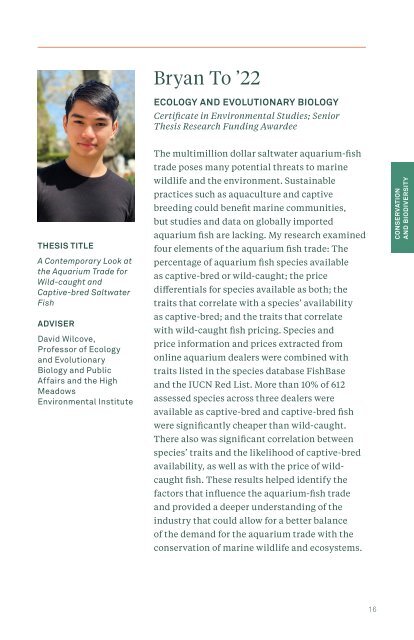Undergraduate Research: An Archive - 2022 Program
You also want an ePaper? Increase the reach of your titles
YUMPU automatically turns print PDFs into web optimized ePapers that Google loves.
Bryan To ’22<br />
ECOLOGY AND EVOLUTIONARY BIOLOGY<br />
Certificate in Environmental Studies; Senior<br />
Thesis <strong>Research</strong> Funding Awardee<br />
THESIS TITLE<br />
A Contemporary Look at<br />
the Aquarium Trade for<br />
Wild-caught and<br />
Captive-bred Saltwater<br />
Fish<br />
ADVISER<br />
David Wilcove,<br />
Professor of Ecology<br />
and Evolutionary<br />
Biology and Public<br />
Affairs and the High<br />
Meadows<br />
Environmental Institute<br />
The multimillion dollar saltwater aquarium-fish<br />
trade poses many potential threats to marine<br />
wildlife and the environment. Sustainable<br />
practices such as aquaculture and captive<br />
breeding could benefit marine communities,<br />
but studies and data on globally imported<br />
aquarium fish are lacking. My research examined<br />
four elements of the aquarium fish trade: The<br />
percentage of aquarium fish species available<br />
as captive-bred or wild-caught; the price<br />
differentials for species available as both; the<br />
traits that correlate with a species’ availability<br />
as captive-bred; and the traits that correlate<br />
with wild-caught fish pricing. Species and<br />
price information and prices extracted from<br />
online aquarium dealers were combined with<br />
traits listed in the species database FishBase<br />
and the IUCN Red List. More than 10% of 612<br />
assessed species across three dealers were<br />
available as captive-bred and captive-bred fish<br />
were significantly cheaper than wild-caught.<br />
There also was significant correlation between<br />
species’ traits and the likelihood of captive-bred<br />
availability, as well as with the price of wildcaught<br />
fish. These results helped identify the<br />
factors that influence the aquarium-fish trade<br />
and provided a deeper understanding of the<br />
industry that could allow for a better balance<br />
of the demand for the aquarium trade with the<br />
conservation of marine wildlife and ecosystems.<br />
CONSERVATION<br />
AND BIODIVERSITY<br />
16
















